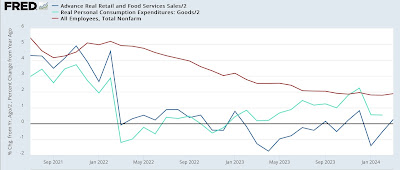– by New Deal democrat The Bonddad Blog As per usual, real retail sales is one of my favorite indicators, because it gives so much information about the consumer, and since consumption leads employment, it helps forecast the trend in the latter as well. And the news this morning was good, as nominally retail sales increased 0.7% in March, while February’s number was revised higher by 0.3% to 0.9%. After accounting for 0.4% inflation in March, real retail sales increased 0.3%, and February was revised up to 0.5%. To the extent there was bad news, it was that January’s -1.2% decline has still not been completely erased. To the graphs: first, below I show the historical record for the past 15+ years of both real retail sales (dark blue)
Topics:
NewDealdemocrat considers the following as important: Hot Topics, real retail sales, US EConomics
This could be interesting, too:
NewDealdemocrat writes JOLTS revisions from Yesterday’s Report
Joel Eissenberg writes No Invading Allies Act
Bill Haskell writes The North American Automobile Industry Waits for Trump and the Gov. to Act
Bill Haskell writes Families Struggle Paying for Child Care While Working
– by New Deal democrat
As per usual, real retail sales is one of my favorite indicators, because it gives so much information about the consumer, and since consumption leads employment, it helps forecast the trend in the latter as well.
And the news this morning was good, as nominally retail sales increased 0.7% in March, while February’s number was revised higher by 0.3% to 0.9%. After accounting for 0.4% inflation in March, real retail sales increased 0.3%, and February was revised up to 0.5%.
To the extent there was bad news, it was that January’s -1.2% decline has still not been completely erased.
To the graphs: first, below I show the historical record for the past 15+ years of both real retail sales (dark blue) and real personal spending on goods (light blue), a similar but more comprehensive measure. The two metrics tend to trend together over time, although the latter has tended to increase more (hence I adjust to bring the trends more in line):
Here is the close-up post-pandemic view:
Real retail sales are still -2.9% below their April 2022 peak, and also about -1% below their nearer term August 2023 peak. Real spending on goods has been more positive. More importantly for the long term trend, real spending on goods has now completely caught up with real retail sales. The bigger picture is that real retail sales have trended neutral, while real spending on goods has trended higher.
Turning to the effect on employment, here is the longer term YoY% gains in both spending measures /2, which is the best match to forecast the near term trend in jobs (red):
Employment doesn’t respond to every noisy move in spending, but does tend to peak and trough about 6 months after spending, and responds to the longer term trend. If FRED allowed 6 or 12 month moving averages, the correspondence would be much closer.
With that caveat, here is the post-pandemic close up:
Historically negative YoY comparisons in real retail sales have usually meant recession, while positive comparisons have almost always meant continued expansion. Needless to say, that didn’t happen in 2022-23. The overall trend since mid-year 2023 has been “less negative” to neutral, while real spending on goods has remained positive.
And as those YoY comparisons in consumption have improved, we have seen the decelerating trend in employment shift to a more consistent “soft landing” scenario. Thus, real retail sales are forecasting continued growth in the neighborhood of the last few months’ numbers going forward through most of this year.
Good news and bad news Thursday: the bad news is real retail sales, Angry Bear by New Deal democrat




